Research Paper on Employee Compensation and Productivity at University
VerifiedAdded on 2023/04/22
|39
|9769
|314
Report
AI Summary
This research paper investigates the relationship between employee compensation and productivity. It begins with an abstract highlighting the issue of employee turnover and the potential impact of inconsistent compensation on productivity. The paper then outlines the background, purpose, aims, objectives, research questions, and hypothesis. A literature review is provided, followed by a detailed methodology section explaining the research philosophy, approach, design, data collection, ethical considerations, and limitations. The results section presents the findings of the data analysis, including frequency distributions, descriptive statistics, regression statistics, and ANOVA results. Finally, the paper concludes with a discussion of the findings, linking them to the research objectives, and offering recommendations for organizations. The study aims to provide valuable insights into how compensation affects employee performance and suggests strategies for improving productivity and employee satisfaction. The research also highlights the significance of understanding compensation's role in employee motivation and retention.
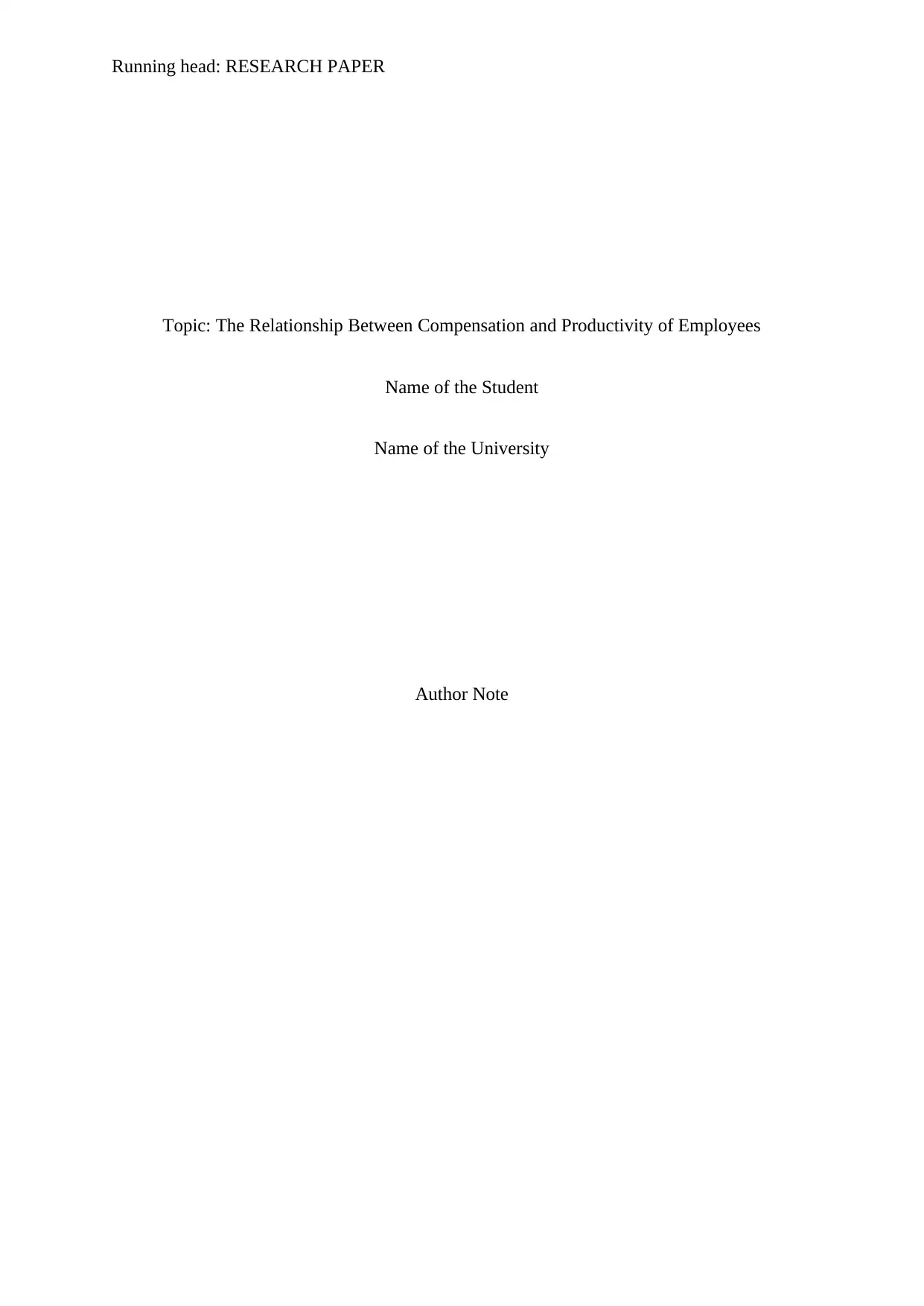
Running head: RESEARCH PAPER
Topic: The Relationship Between Compensation and Productivity of Employees
Name of the Student
Name of the University
Author Note
Topic: The Relationship Between Compensation and Productivity of Employees
Name of the Student
Name of the University
Author Note
Paraphrase This Document
Need a fresh take? Get an instant paraphrase of this document with our AI Paraphraser
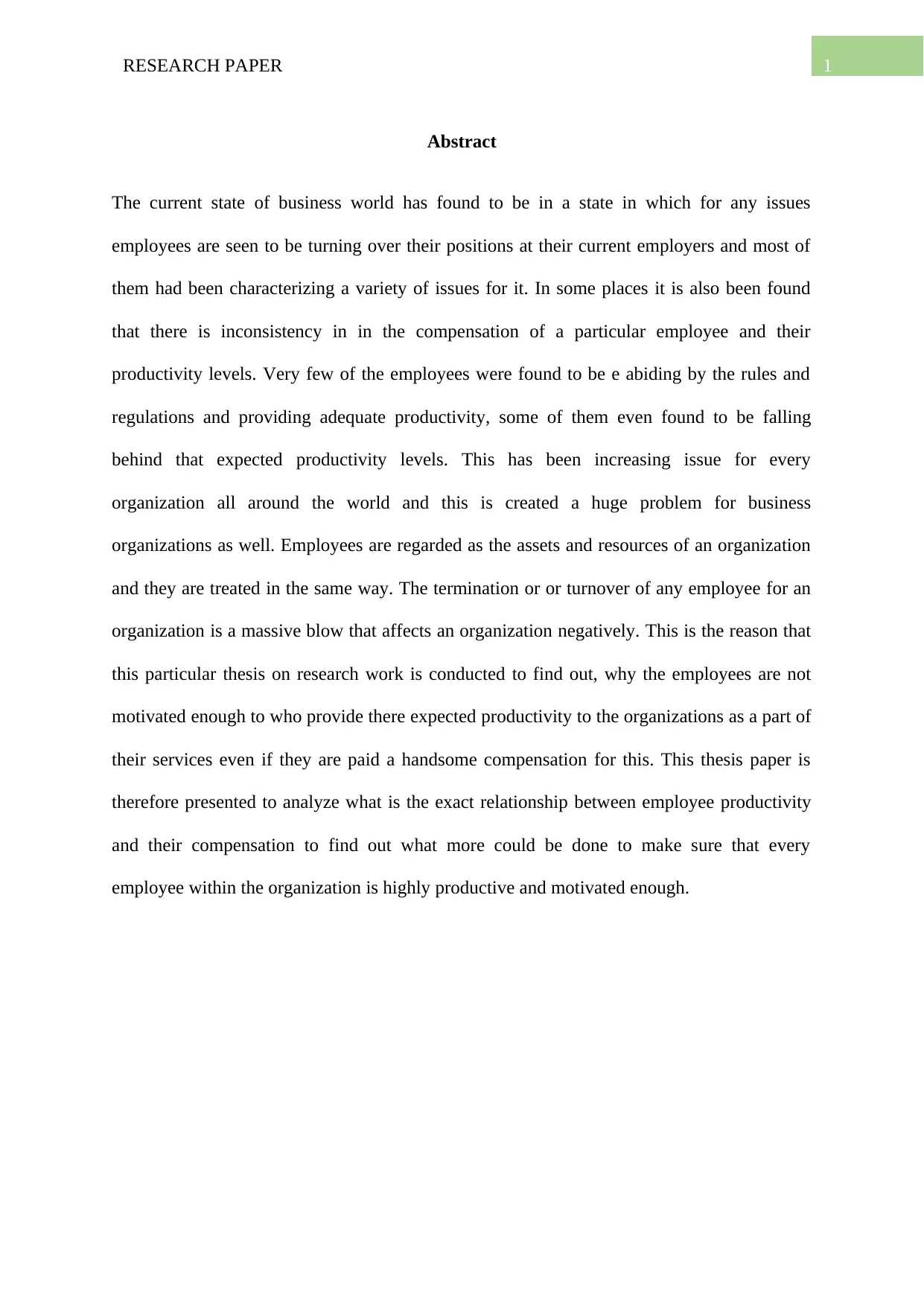
1RESEARCH PAPER
Abstract
The current state of business world has found to be in a state in which for any issues
employees are seen to be turning over their positions at their current employers and most of
them had been characterizing a variety of issues for it. In some places it is also been found
that there is inconsistency in in the compensation of a particular employee and their
productivity levels. Very few of the employees were found to be e abiding by the rules and
regulations and providing adequate productivity, some of them even found to be falling
behind that expected productivity levels. This has been increasing issue for every
organization all around the world and this is created a huge problem for business
organizations as well. Employees are regarded as the assets and resources of an organization
and they are treated in the same way. The termination or or turnover of any employee for an
organization is a massive blow that affects an organization negatively. This is the reason that
this particular thesis on research work is conducted to find out, why the employees are not
motivated enough to who provide there expected productivity to the organizations as a part of
their services even if they are paid a handsome compensation for this. This thesis paper is
therefore presented to analyze what is the exact relationship between employee productivity
and their compensation to find out what more could be done to make sure that every
employee within the organization is highly productive and motivated enough.
Abstract
The current state of business world has found to be in a state in which for any issues
employees are seen to be turning over their positions at their current employers and most of
them had been characterizing a variety of issues for it. In some places it is also been found
that there is inconsistency in in the compensation of a particular employee and their
productivity levels. Very few of the employees were found to be e abiding by the rules and
regulations and providing adequate productivity, some of them even found to be falling
behind that expected productivity levels. This has been increasing issue for every
organization all around the world and this is created a huge problem for business
organizations as well. Employees are regarded as the assets and resources of an organization
and they are treated in the same way. The termination or or turnover of any employee for an
organization is a massive blow that affects an organization negatively. This is the reason that
this particular thesis on research work is conducted to find out, why the employees are not
motivated enough to who provide there expected productivity to the organizations as a part of
their services even if they are paid a handsome compensation for this. This thesis paper is
therefore presented to analyze what is the exact relationship between employee productivity
and their compensation to find out what more could be done to make sure that every
employee within the organization is highly productive and motivated enough.
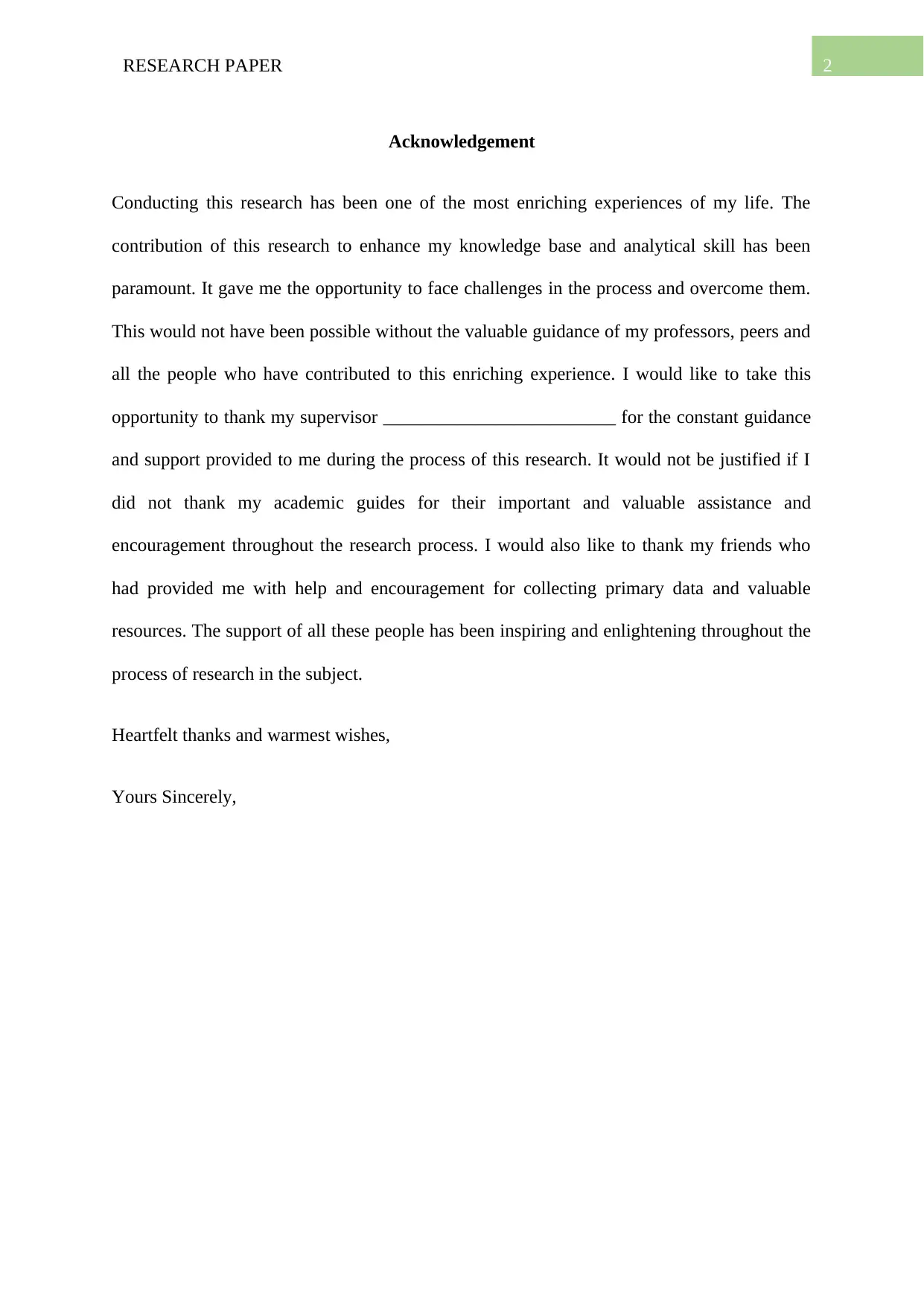
2RESEARCH PAPER
Acknowledgement
Conducting this research has been one of the most enriching experiences of my life. The
contribution of this research to enhance my knowledge base and analytical skill has been
paramount. It gave me the opportunity to face challenges in the process and overcome them.
This would not have been possible without the valuable guidance of my professors, peers and
all the people who have contributed to this enriching experience. I would like to take this
opportunity to thank my supervisor _________________________ for the constant guidance
and support provided to me during the process of this research. It would not be justified if I
did not thank my academic guides for their important and valuable assistance and
encouragement throughout the research process. I would also like to thank my friends who
had provided me with help and encouragement for collecting primary data and valuable
resources. The support of all these people has been inspiring and enlightening throughout the
process of research in the subject.
Heartfelt thanks and warmest wishes,
Yours Sincerely,
Acknowledgement
Conducting this research has been one of the most enriching experiences of my life. The
contribution of this research to enhance my knowledge base and analytical skill has been
paramount. It gave me the opportunity to face challenges in the process and overcome them.
This would not have been possible without the valuable guidance of my professors, peers and
all the people who have contributed to this enriching experience. I would like to take this
opportunity to thank my supervisor _________________________ for the constant guidance
and support provided to me during the process of this research. It would not be justified if I
did not thank my academic guides for their important and valuable assistance and
encouragement throughout the research process. I would also like to thank my friends who
had provided me with help and encouragement for collecting primary data and valuable
resources. The support of all these people has been inspiring and enlightening throughout the
process of research in the subject.
Heartfelt thanks and warmest wishes,
Yours Sincerely,
⊘ This is a preview!⊘
Do you want full access?
Subscribe today to unlock all pages.

Trusted by 1+ million students worldwide
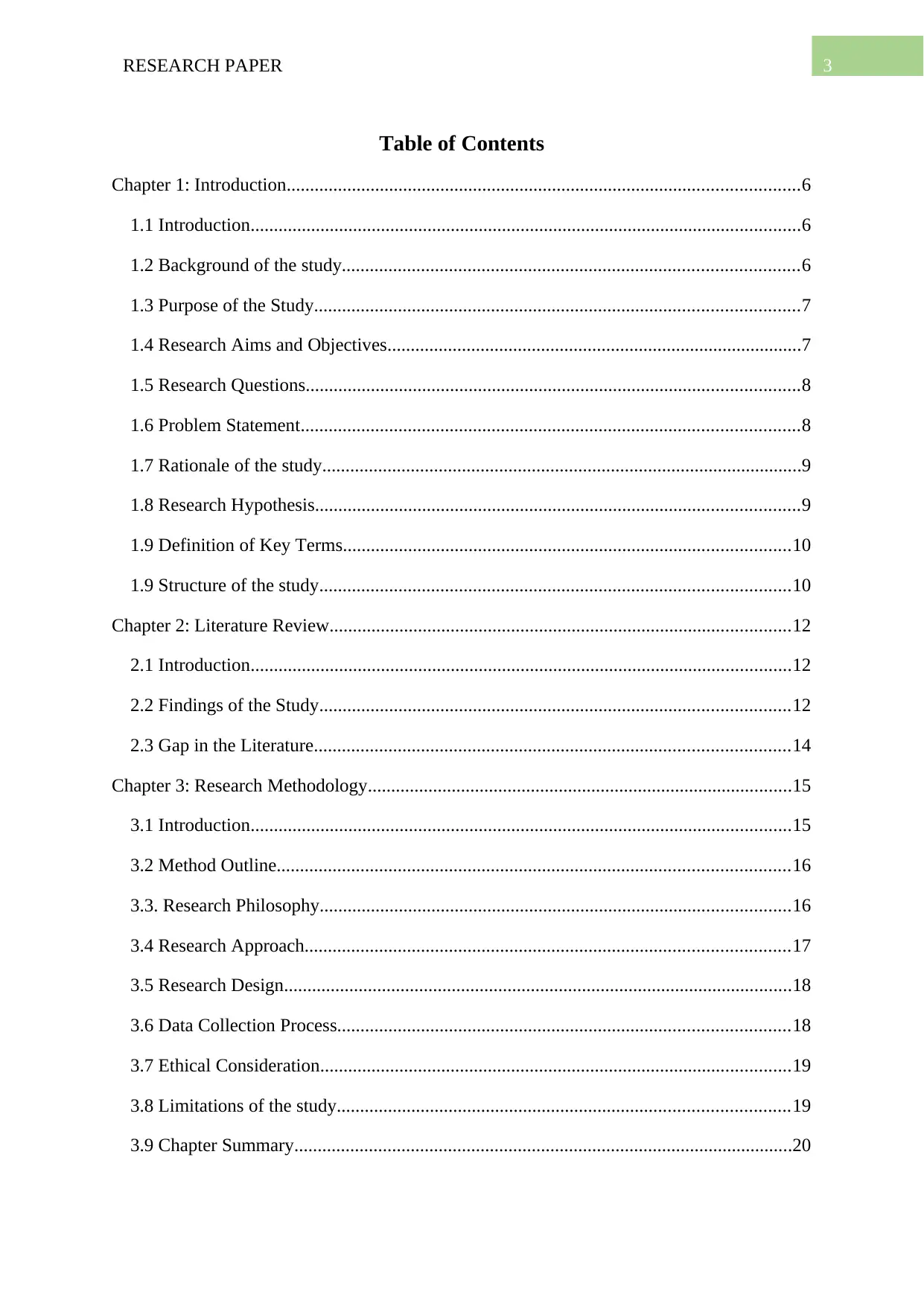
3RESEARCH PAPER
Table of Contents
Chapter 1: Introduction..............................................................................................................6
1.1 Introduction......................................................................................................................6
1.2 Background of the study..................................................................................................6
1.3 Purpose of the Study........................................................................................................7
1.4 Research Aims and Objectives.........................................................................................7
1.5 Research Questions..........................................................................................................8
1.6 Problem Statement...........................................................................................................8
1.7 Rationale of the study.......................................................................................................9
1.8 Research Hypothesis........................................................................................................9
1.9 Definition of Key Terms................................................................................................10
1.9 Structure of the study.....................................................................................................10
Chapter 2: Literature Review...................................................................................................12
2.1 Introduction....................................................................................................................12
2.2 Findings of the Study.....................................................................................................12
2.3 Gap in the Literature......................................................................................................14
Chapter 3: Research Methodology...........................................................................................15
3.1 Introduction....................................................................................................................15
3.2 Method Outline..............................................................................................................16
3.3. Research Philosophy.....................................................................................................16
3.4 Research Approach........................................................................................................17
3.5 Research Design.............................................................................................................18
3.6 Data Collection Process.................................................................................................18
3.7 Ethical Consideration.....................................................................................................19
3.8 Limitations of the study.................................................................................................19
3.9 Chapter Summary...........................................................................................................20
Table of Contents
Chapter 1: Introduction..............................................................................................................6
1.1 Introduction......................................................................................................................6
1.2 Background of the study..................................................................................................6
1.3 Purpose of the Study........................................................................................................7
1.4 Research Aims and Objectives.........................................................................................7
1.5 Research Questions..........................................................................................................8
1.6 Problem Statement...........................................................................................................8
1.7 Rationale of the study.......................................................................................................9
1.8 Research Hypothesis........................................................................................................9
1.9 Definition of Key Terms................................................................................................10
1.9 Structure of the study.....................................................................................................10
Chapter 2: Literature Review...................................................................................................12
2.1 Introduction....................................................................................................................12
2.2 Findings of the Study.....................................................................................................12
2.3 Gap in the Literature......................................................................................................14
Chapter 3: Research Methodology...........................................................................................15
3.1 Introduction....................................................................................................................15
3.2 Method Outline..............................................................................................................16
3.3. Research Philosophy.....................................................................................................16
3.4 Research Approach........................................................................................................17
3.5 Research Design.............................................................................................................18
3.6 Data Collection Process.................................................................................................18
3.7 Ethical Consideration.....................................................................................................19
3.8 Limitations of the study.................................................................................................19
3.9 Chapter Summary...........................................................................................................20
Paraphrase This Document
Need a fresh take? Get an instant paraphrase of this document with our AI Paraphraser
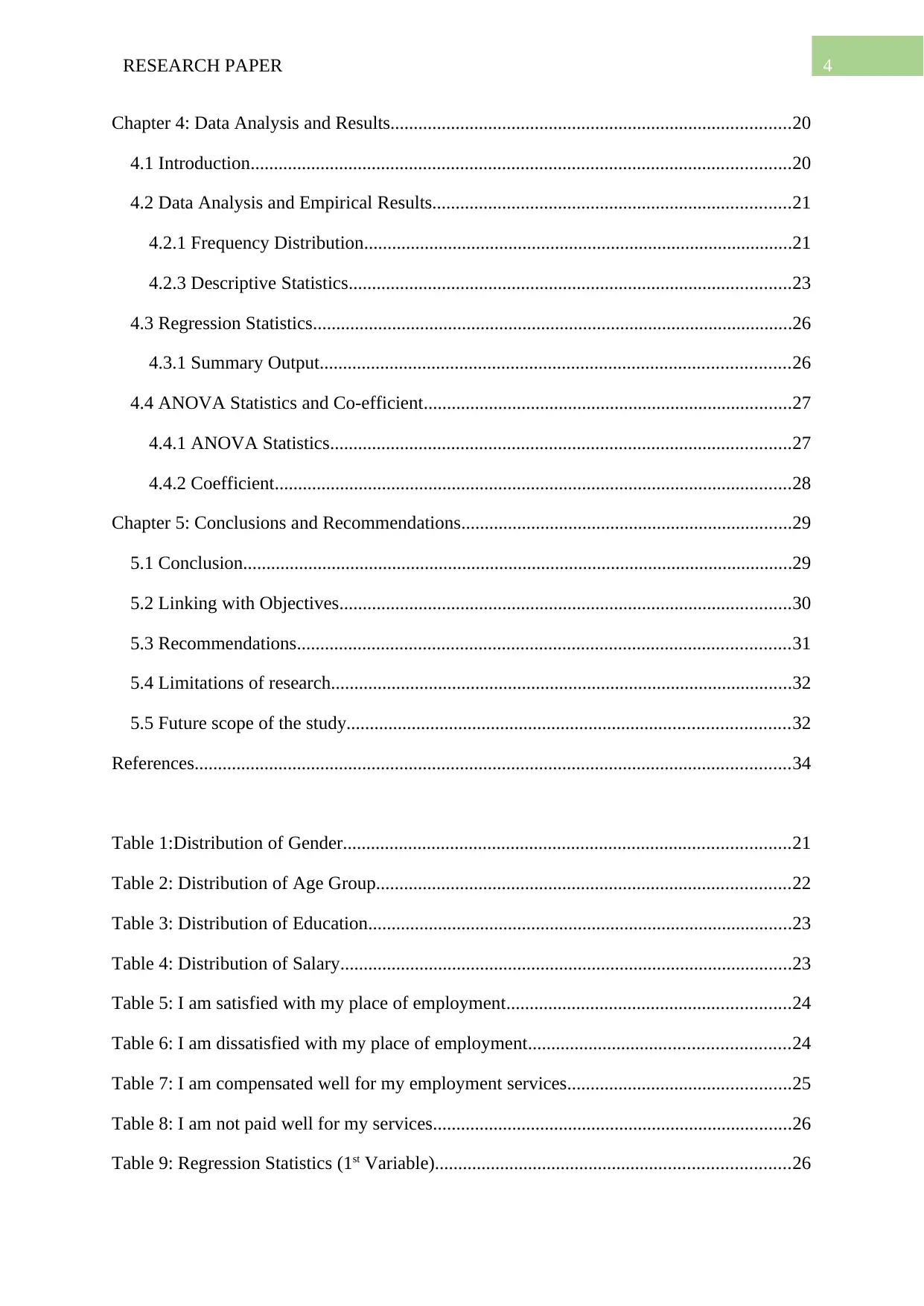
4RESEARCH PAPER
Chapter 4: Data Analysis and Results......................................................................................20
4.1 Introduction....................................................................................................................20
4.2 Data Analysis and Empirical Results.............................................................................21
4.2.1 Frequency Distribution............................................................................................21
4.2.3 Descriptive Statistics...............................................................................................23
4.3 Regression Statistics.......................................................................................................26
4.3.1 Summary Output.....................................................................................................26
4.4 ANOVA Statistics and Co-efficient...............................................................................27
4.4.1 ANOVA Statistics...................................................................................................27
4.4.2 Coefficient...............................................................................................................28
Chapter 5: Conclusions and Recommendations.......................................................................29
5.1 Conclusion......................................................................................................................29
5.2 Linking with Objectives.................................................................................................30
5.3 Recommendations..........................................................................................................31
5.4 Limitations of research...................................................................................................32
5.5 Future scope of the study...............................................................................................32
References................................................................................................................................34
Table 1:Distribution of Gender................................................................................................21
Table 2: Distribution of Age Group.........................................................................................22
Table 3: Distribution of Education...........................................................................................23
Table 4: Distribution of Salary.................................................................................................23
Table 5: I am satisfied with my place of employment.............................................................24
Table 6: I am dissatisfied with my place of employment........................................................24
Table 7: I am compensated well for my employment services................................................25
Table 8: I am not paid well for my services.............................................................................26
Table 9: Regression Statistics (1st Variable)............................................................................26
Chapter 4: Data Analysis and Results......................................................................................20
4.1 Introduction....................................................................................................................20
4.2 Data Analysis and Empirical Results.............................................................................21
4.2.1 Frequency Distribution............................................................................................21
4.2.3 Descriptive Statistics...............................................................................................23
4.3 Regression Statistics.......................................................................................................26
4.3.1 Summary Output.....................................................................................................26
4.4 ANOVA Statistics and Co-efficient...............................................................................27
4.4.1 ANOVA Statistics...................................................................................................27
4.4.2 Coefficient...............................................................................................................28
Chapter 5: Conclusions and Recommendations.......................................................................29
5.1 Conclusion......................................................................................................................29
5.2 Linking with Objectives.................................................................................................30
5.3 Recommendations..........................................................................................................31
5.4 Limitations of research...................................................................................................32
5.5 Future scope of the study...............................................................................................32
References................................................................................................................................34
Table 1:Distribution of Gender................................................................................................21
Table 2: Distribution of Age Group.........................................................................................22
Table 3: Distribution of Education...........................................................................................23
Table 4: Distribution of Salary.................................................................................................23
Table 5: I am satisfied with my place of employment.............................................................24
Table 6: I am dissatisfied with my place of employment........................................................24
Table 7: I am compensated well for my employment services................................................25
Table 8: I am not paid well for my services.............................................................................26
Table 9: Regression Statistics (1st Variable)............................................................................26
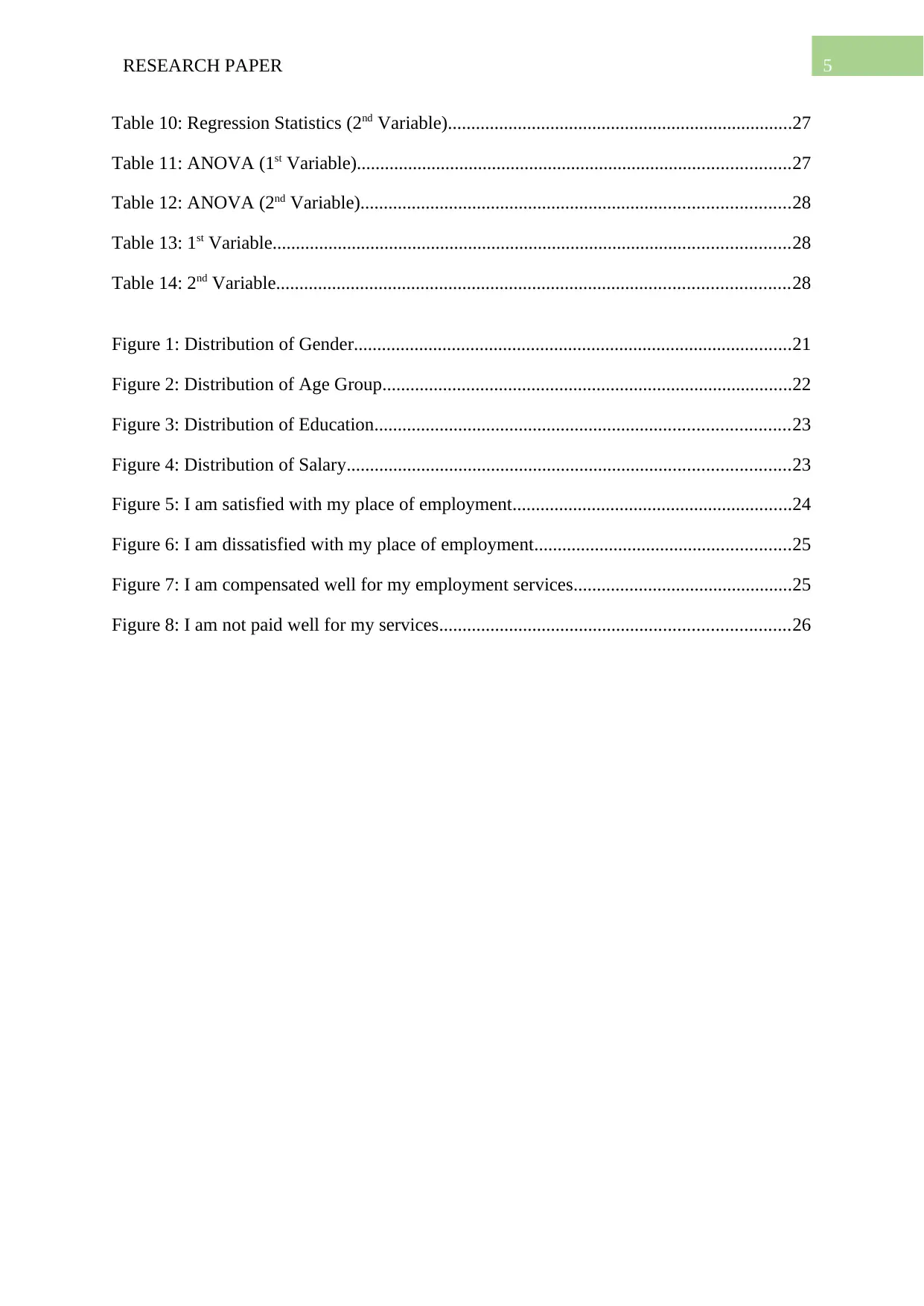
5RESEARCH PAPER
Table 10: Regression Statistics (2nd Variable)..........................................................................27
Table 11: ANOVA (1st Variable).............................................................................................27
Table 12: ANOVA (2nd Variable)............................................................................................28
Table 13: 1st Variable...............................................................................................................28
Table 14: 2nd Variable..............................................................................................................28
Figure 1: Distribution of Gender..............................................................................................21
Figure 2: Distribution of Age Group........................................................................................22
Figure 3: Distribution of Education.........................................................................................23
Figure 4: Distribution of Salary...............................................................................................23
Figure 5: I am satisfied with my place of employment............................................................24
Figure 6: I am dissatisfied with my place of employment.......................................................25
Figure 7: I am compensated well for my employment services...............................................25
Figure 8: I am not paid well for my services...........................................................................26
Table 10: Regression Statistics (2nd Variable)..........................................................................27
Table 11: ANOVA (1st Variable).............................................................................................27
Table 12: ANOVA (2nd Variable)............................................................................................28
Table 13: 1st Variable...............................................................................................................28
Table 14: 2nd Variable..............................................................................................................28
Figure 1: Distribution of Gender..............................................................................................21
Figure 2: Distribution of Age Group........................................................................................22
Figure 3: Distribution of Education.........................................................................................23
Figure 4: Distribution of Salary...............................................................................................23
Figure 5: I am satisfied with my place of employment............................................................24
Figure 6: I am dissatisfied with my place of employment.......................................................25
Figure 7: I am compensated well for my employment services...............................................25
Figure 8: I am not paid well for my services...........................................................................26
⊘ This is a preview!⊘
Do you want full access?
Subscribe today to unlock all pages.

Trusted by 1+ million students worldwide
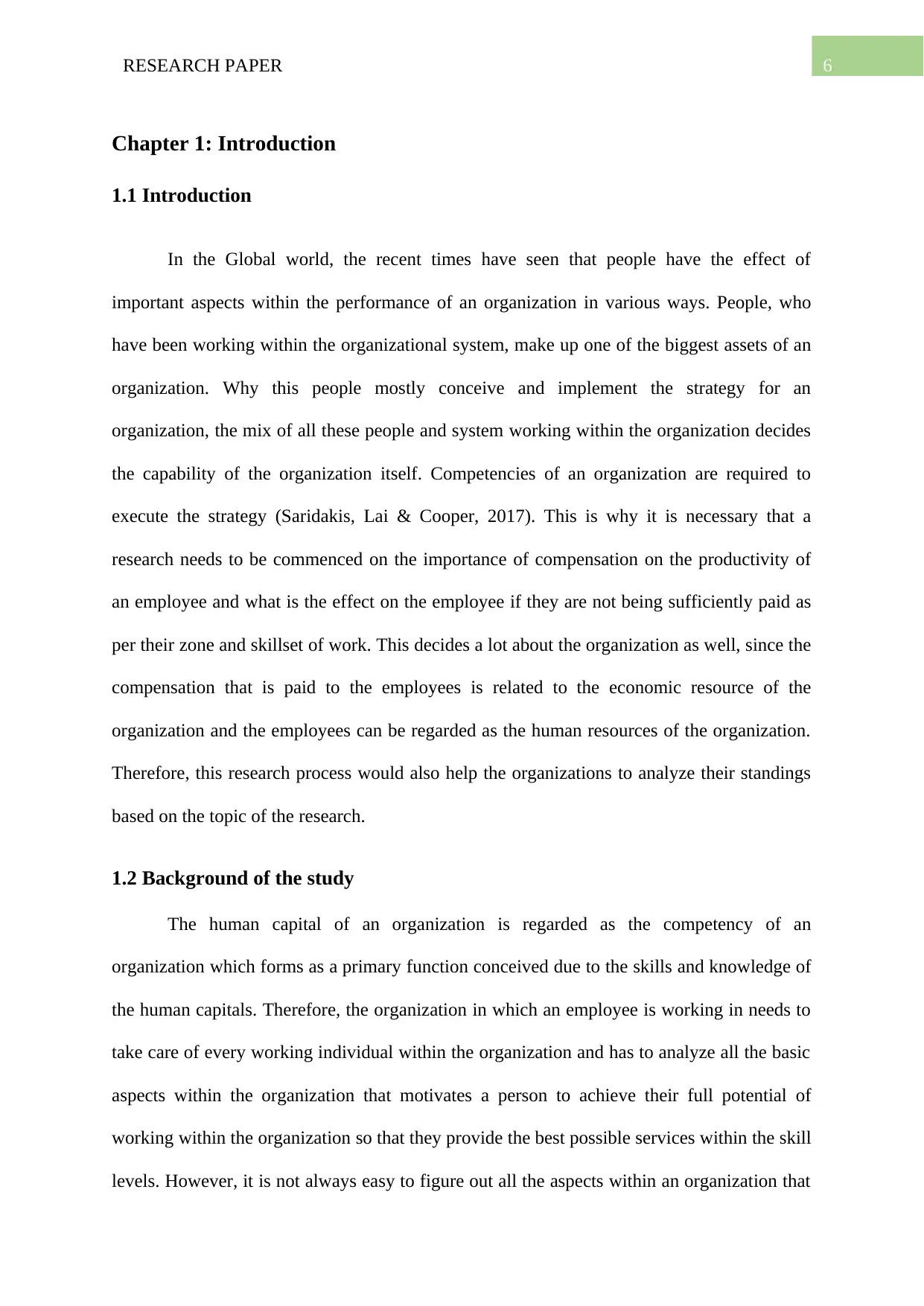
6RESEARCH PAPER
Chapter 1: Introduction
1.1 Introduction
In the Global world, the recent times have seen that people have the effect of
important aspects within the performance of an organization in various ways. People, who
have been working within the organizational system, make up one of the biggest assets of an
organization. Why this people mostly conceive and implement the strategy for an
organization, the mix of all these people and system working within the organization decides
the capability of the organization itself. Competencies of an organization are required to
execute the strategy (Saridakis, Lai & Cooper, 2017). This is why it is necessary that a
research needs to be commenced on the importance of compensation on the productivity of
an employee and what is the effect on the employee if they are not being sufficiently paid as
per their zone and skillset of work. This decides a lot about the organization as well, since the
compensation that is paid to the employees is related to the economic resource of the
organization and the employees can be regarded as the human resources of the organization.
Therefore, this research process would also help the organizations to analyze their standings
based on the topic of the research.
1.2 Background of the study
The human capital of an organization is regarded as the competency of an
organization which forms as a primary function conceived due to the skills and knowledge of
the human capitals. Therefore, the organization in which an employee is working in needs to
take care of every working individual within the organization and has to analyze all the basic
aspects within the organization that motivates a person to achieve their full potential of
working within the organization so that they provide the best possible services within the skill
levels. However, it is not always easy to figure out all the aspects within an organization that
Chapter 1: Introduction
1.1 Introduction
In the Global world, the recent times have seen that people have the effect of
important aspects within the performance of an organization in various ways. People, who
have been working within the organizational system, make up one of the biggest assets of an
organization. Why this people mostly conceive and implement the strategy for an
organization, the mix of all these people and system working within the organization decides
the capability of the organization itself. Competencies of an organization are required to
execute the strategy (Saridakis, Lai & Cooper, 2017). This is why it is necessary that a
research needs to be commenced on the importance of compensation on the productivity of
an employee and what is the effect on the employee if they are not being sufficiently paid as
per their zone and skillset of work. This decides a lot about the organization as well, since the
compensation that is paid to the employees is related to the economic resource of the
organization and the employees can be regarded as the human resources of the organization.
Therefore, this research process would also help the organizations to analyze their standings
based on the topic of the research.
1.2 Background of the study
The human capital of an organization is regarded as the competency of an
organization which forms as a primary function conceived due to the skills and knowledge of
the human capitals. Therefore, the organization in which an employee is working in needs to
take care of every working individual within the organization and has to analyze all the basic
aspects within the organization that motivates a person to achieve their full potential of
working within the organization so that they provide the best possible services within the skill
levels. However, it is not always easy to figure out all the aspects within an organization that
Paraphrase This Document
Need a fresh take? Get an instant paraphrase of this document with our AI Paraphraser
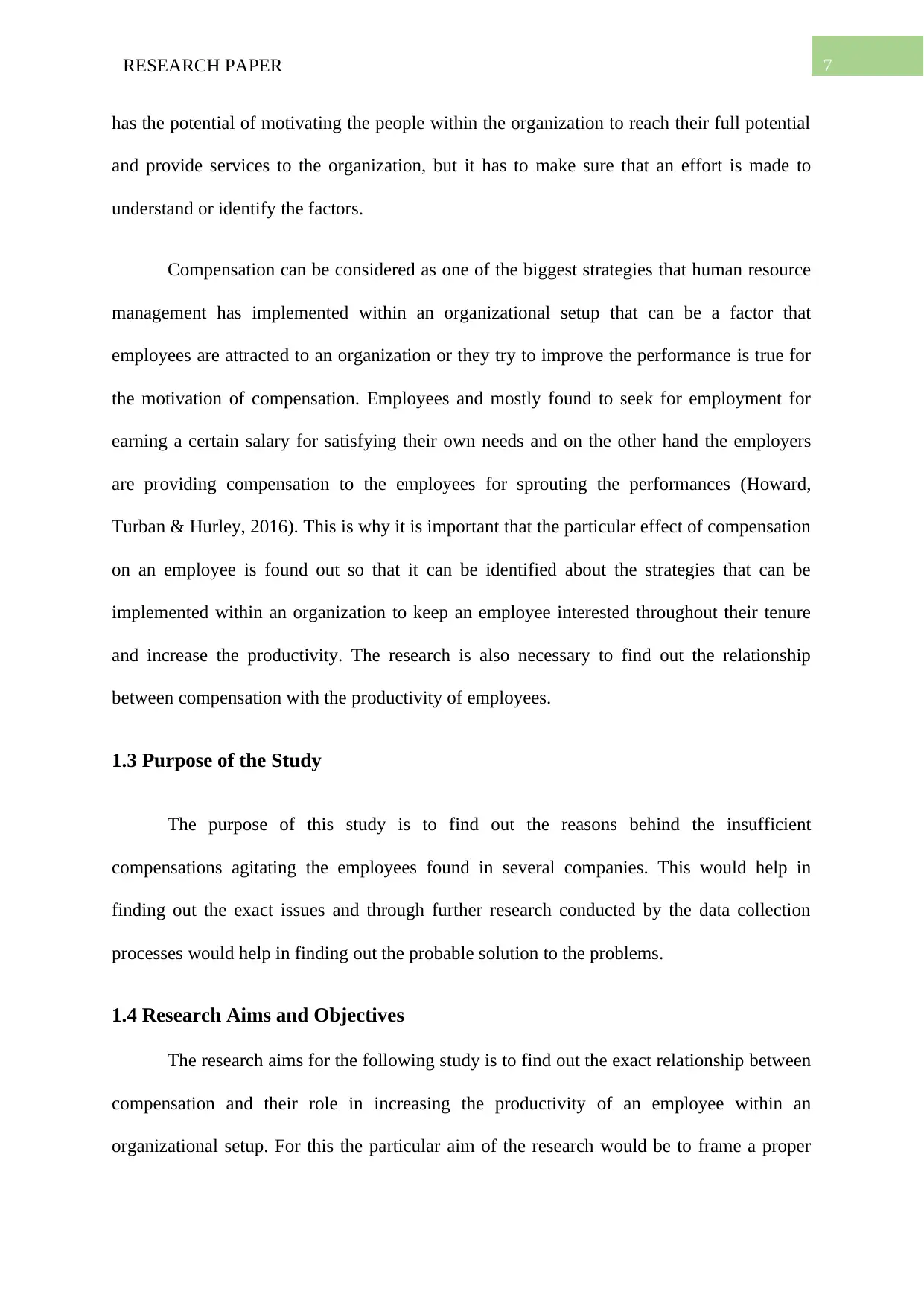
7RESEARCH PAPER
has the potential of motivating the people within the organization to reach their full potential
and provide services to the organization, but it has to make sure that an effort is made to
understand or identify the factors.
Compensation can be considered as one of the biggest strategies that human resource
management has implemented within an organizational setup that can be a factor that
employees are attracted to an organization or they try to improve the performance is true for
the motivation of compensation. Employees and mostly found to seek for employment for
earning a certain salary for satisfying their own needs and on the other hand the employers
are providing compensation to the employees for sprouting the performances (Howard,
Turban & Hurley, 2016). This is why it is important that the particular effect of compensation
on an employee is found out so that it can be identified about the strategies that can be
implemented within an organization to keep an employee interested throughout their tenure
and increase the productivity. The research is also necessary to find out the relationship
between compensation with the productivity of employees.
1.3 Purpose of the Study
The purpose of this study is to find out the reasons behind the insufficient
compensations agitating the employees found in several companies. This would help in
finding out the exact issues and through further research conducted by the data collection
processes would help in finding out the probable solution to the problems.
1.4 Research Aims and Objectives
The research aims for the following study is to find out the exact relationship between
compensation and their role in increasing the productivity of an employee within an
organizational setup. For this the particular aim of the research would be to frame a proper
has the potential of motivating the people within the organization to reach their full potential
and provide services to the organization, but it has to make sure that an effort is made to
understand or identify the factors.
Compensation can be considered as one of the biggest strategies that human resource
management has implemented within an organizational setup that can be a factor that
employees are attracted to an organization or they try to improve the performance is true for
the motivation of compensation. Employees and mostly found to seek for employment for
earning a certain salary for satisfying their own needs and on the other hand the employers
are providing compensation to the employees for sprouting the performances (Howard,
Turban & Hurley, 2016). This is why it is important that the particular effect of compensation
on an employee is found out so that it can be identified about the strategies that can be
implemented within an organization to keep an employee interested throughout their tenure
and increase the productivity. The research is also necessary to find out the relationship
between compensation with the productivity of employees.
1.3 Purpose of the Study
The purpose of this study is to find out the reasons behind the insufficient
compensations agitating the employees found in several companies. This would help in
finding out the exact issues and through further research conducted by the data collection
processes would help in finding out the probable solution to the problems.
1.4 Research Aims and Objectives
The research aims for the following study is to find out the exact relationship between
compensation and their role in increasing the productivity of an employee within an
organizational setup. For this the particular aim of the research would be to frame a proper
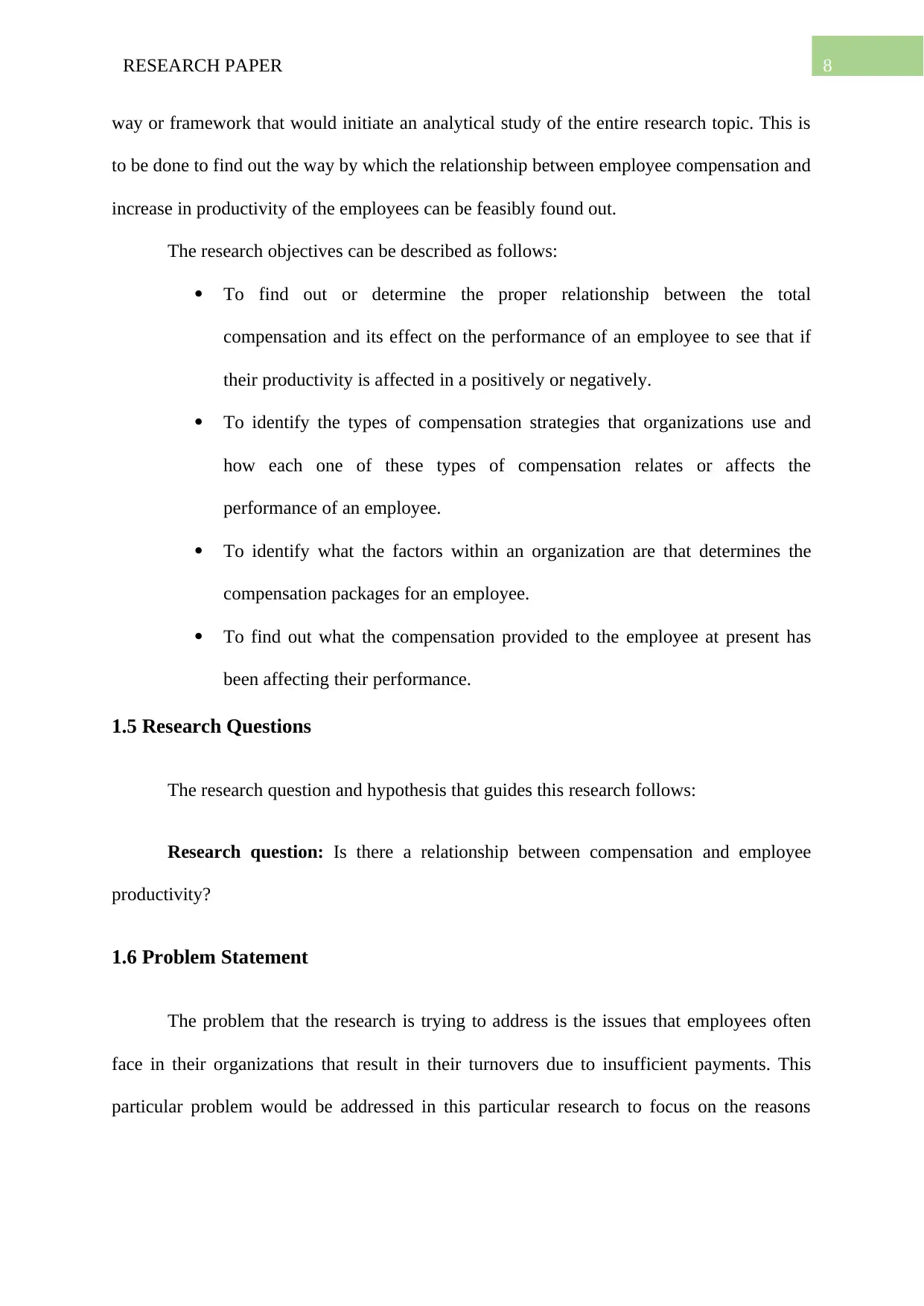
8RESEARCH PAPER
way or framework that would initiate an analytical study of the entire research topic. This is
to be done to find out the way by which the relationship between employee compensation and
increase in productivity of the employees can be feasibly found out.
The research objectives can be described as follows:
To find out or determine the proper relationship between the total
compensation and its effect on the performance of an employee to see that if
their productivity is affected in a positively or negatively.
To identify the types of compensation strategies that organizations use and
how each one of these types of compensation relates or affects the
performance of an employee.
To identify what the factors within an organization are that determines the
compensation packages for an employee.
To find out what the compensation provided to the employee at present has
been affecting their performance.
1.5 Research Questions
The research question and hypothesis that guides this research follows:
Research question: Is there a relationship between compensation and employee
productivity?
1.6 Problem Statement
The problem that the research is trying to address is the issues that employees often
face in their organizations that result in their turnovers due to insufficient payments. This
particular problem would be addressed in this particular research to focus on the reasons
way or framework that would initiate an analytical study of the entire research topic. This is
to be done to find out the way by which the relationship between employee compensation and
increase in productivity of the employees can be feasibly found out.
The research objectives can be described as follows:
To find out or determine the proper relationship between the total
compensation and its effect on the performance of an employee to see that if
their productivity is affected in a positively or negatively.
To identify the types of compensation strategies that organizations use and
how each one of these types of compensation relates or affects the
performance of an employee.
To identify what the factors within an organization are that determines the
compensation packages for an employee.
To find out what the compensation provided to the employee at present has
been affecting their performance.
1.5 Research Questions
The research question and hypothesis that guides this research follows:
Research question: Is there a relationship between compensation and employee
productivity?
1.6 Problem Statement
The problem that the research is trying to address is the issues that employees often
face in their organizations that result in their turnovers due to insufficient payments. This
particular problem would be addressed in this particular research to focus on the reasons
⊘ This is a preview!⊘
Do you want full access?
Subscribe today to unlock all pages.

Trusted by 1+ million students worldwide
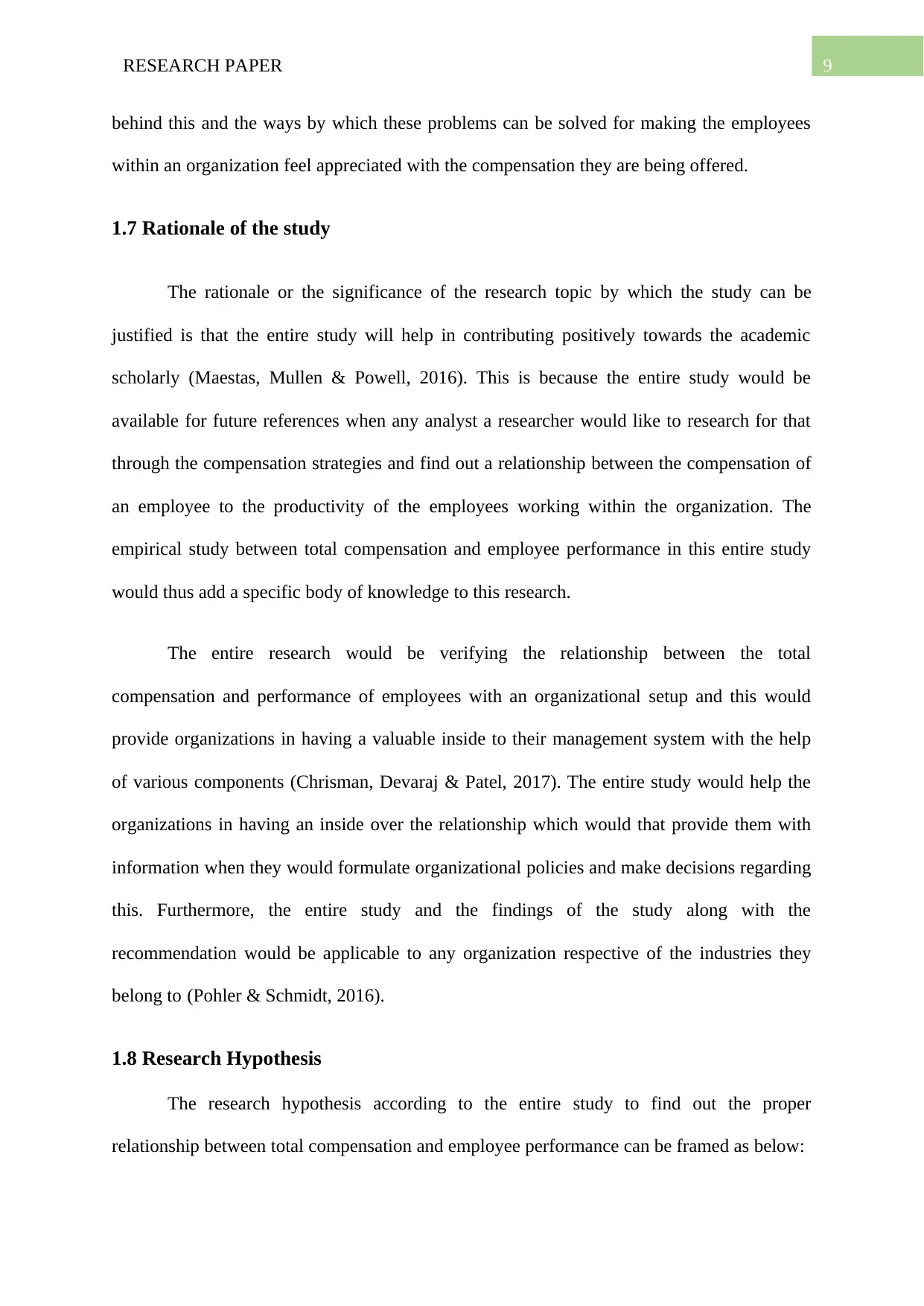
9RESEARCH PAPER
behind this and the ways by which these problems can be solved for making the employees
within an organization feel appreciated with the compensation they are being offered.
1.7 Rationale of the study
The rationale or the significance of the research topic by which the study can be
justified is that the entire study will help in contributing positively towards the academic
scholarly (Maestas, Mullen & Powell, 2016). This is because the entire study would be
available for future references when any analyst a researcher would like to research for that
through the compensation strategies and find out a relationship between the compensation of
an employee to the productivity of the employees working within the organization. The
empirical study between total compensation and employee performance in this entire study
would thus add a specific body of knowledge to this research.
The entire research would be verifying the relationship between the total
compensation and performance of employees with an organizational setup and this would
provide organizations in having a valuable inside to their management system with the help
of various components (Chrisman, Devaraj & Patel, 2017). The entire study would help the
organizations in having an inside over the relationship which would that provide them with
information when they would formulate organizational policies and make decisions regarding
this. Furthermore, the entire study and the findings of the study along with the
recommendation would be applicable to any organization respective of the industries they
belong to (Pohler & Schmidt, 2016).
1.8 Research Hypothesis
The research hypothesis according to the entire study to find out the proper
relationship between total compensation and employee performance can be framed as below:
behind this and the ways by which these problems can be solved for making the employees
within an organization feel appreciated with the compensation they are being offered.
1.7 Rationale of the study
The rationale or the significance of the research topic by which the study can be
justified is that the entire study will help in contributing positively towards the academic
scholarly (Maestas, Mullen & Powell, 2016). This is because the entire study would be
available for future references when any analyst a researcher would like to research for that
through the compensation strategies and find out a relationship between the compensation of
an employee to the productivity of the employees working within the organization. The
empirical study between total compensation and employee performance in this entire study
would thus add a specific body of knowledge to this research.
The entire research would be verifying the relationship between the total
compensation and performance of employees with an organizational setup and this would
provide organizations in having a valuable inside to their management system with the help
of various components (Chrisman, Devaraj & Patel, 2017). The entire study would help the
organizations in having an inside over the relationship which would that provide them with
information when they would formulate organizational policies and make decisions regarding
this. Furthermore, the entire study and the findings of the study along with the
recommendation would be applicable to any organization respective of the industries they
belong to (Pohler & Schmidt, 2016).
1.8 Research Hypothesis
The research hypothesis according to the entire study to find out the proper
relationship between total compensation and employee performance can be framed as below:
Paraphrase This Document
Need a fresh take? Get an instant paraphrase of this document with our AI Paraphraser
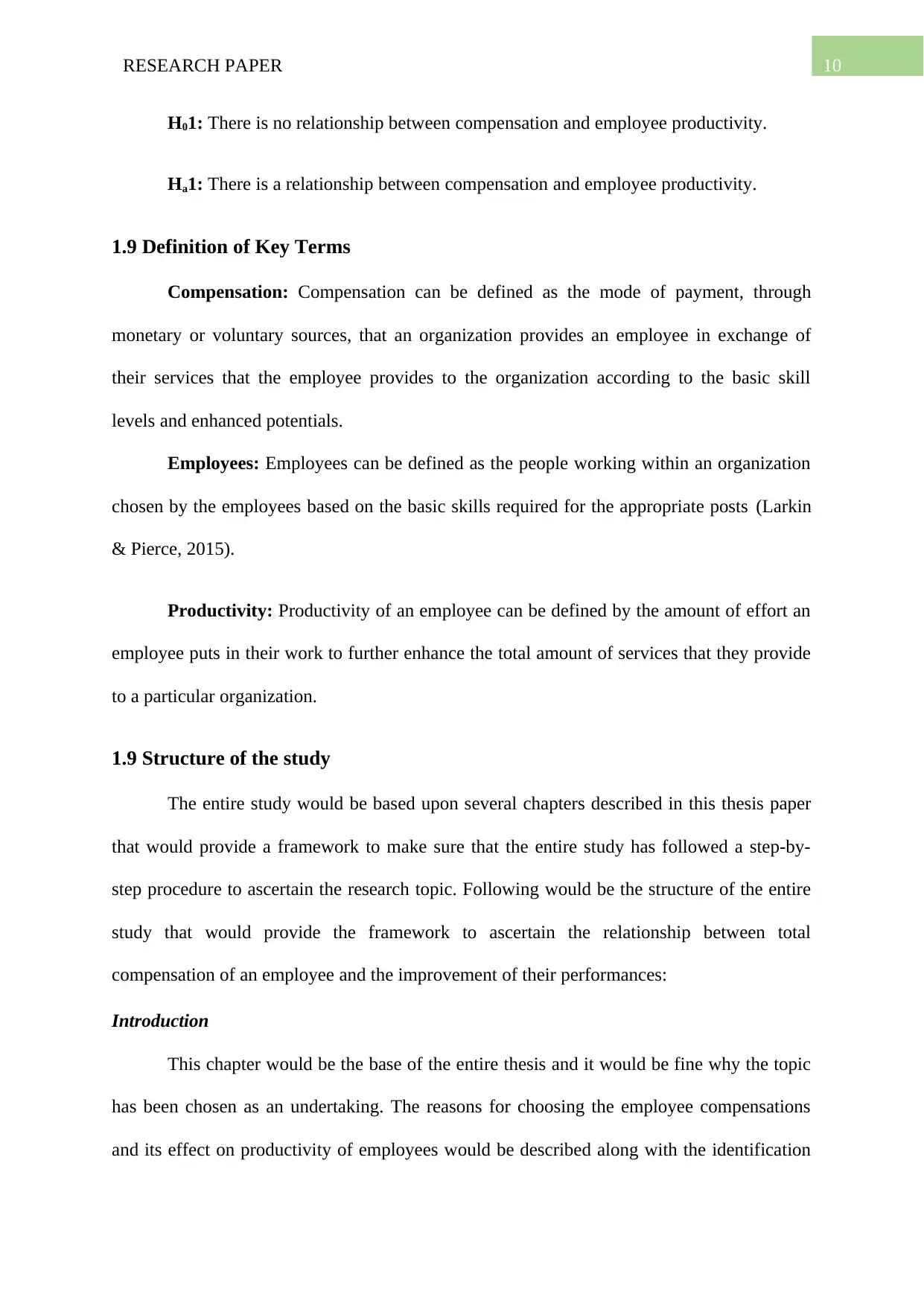
10RESEARCH PAPER
H01: There is no relationship between compensation and employee productivity.
Ha1: There is a relationship between compensation and employee productivity.
1.9 Definition of Key Terms
Compensation: Compensation can be defined as the mode of payment, through
monetary or voluntary sources, that an organization provides an employee in exchange of
their services that the employee provides to the organization according to the basic skill
levels and enhanced potentials.
Employees: Employees can be defined as the people working within an organization
chosen by the employees based on the basic skills required for the appropriate posts (Larkin
& Pierce, 2015).
Productivity: Productivity of an employee can be defined by the amount of effort an
employee puts in their work to further enhance the total amount of services that they provide
to a particular organization.
1.9 Structure of the study
The entire study would be based upon several chapters described in this thesis paper
that would provide a framework to make sure that the entire study has followed a step-by-
step procedure to ascertain the research topic. Following would be the structure of the entire
study that would provide the framework to ascertain the relationship between total
compensation of an employee and the improvement of their performances:
Introduction
This chapter would be the base of the entire thesis and it would be fine why the topic
has been chosen as an undertaking. The reasons for choosing the employee compensations
and its effect on productivity of employees would be described along with the identification
H01: There is no relationship between compensation and employee productivity.
Ha1: There is a relationship between compensation and employee productivity.
1.9 Definition of Key Terms
Compensation: Compensation can be defined as the mode of payment, through
monetary or voluntary sources, that an organization provides an employee in exchange of
their services that the employee provides to the organization according to the basic skill
levels and enhanced potentials.
Employees: Employees can be defined as the people working within an organization
chosen by the employees based on the basic skills required for the appropriate posts (Larkin
& Pierce, 2015).
Productivity: Productivity of an employee can be defined by the amount of effort an
employee puts in their work to further enhance the total amount of services that they provide
to a particular organization.
1.9 Structure of the study
The entire study would be based upon several chapters described in this thesis paper
that would provide a framework to make sure that the entire study has followed a step-by-
step procedure to ascertain the research topic. Following would be the structure of the entire
study that would provide the framework to ascertain the relationship between total
compensation of an employee and the improvement of their performances:
Introduction
This chapter would be the base of the entire thesis and it would be fine why the topic
has been chosen as an undertaking. The reasons for choosing the employee compensations
and its effect on productivity of employees would be described along with the identification
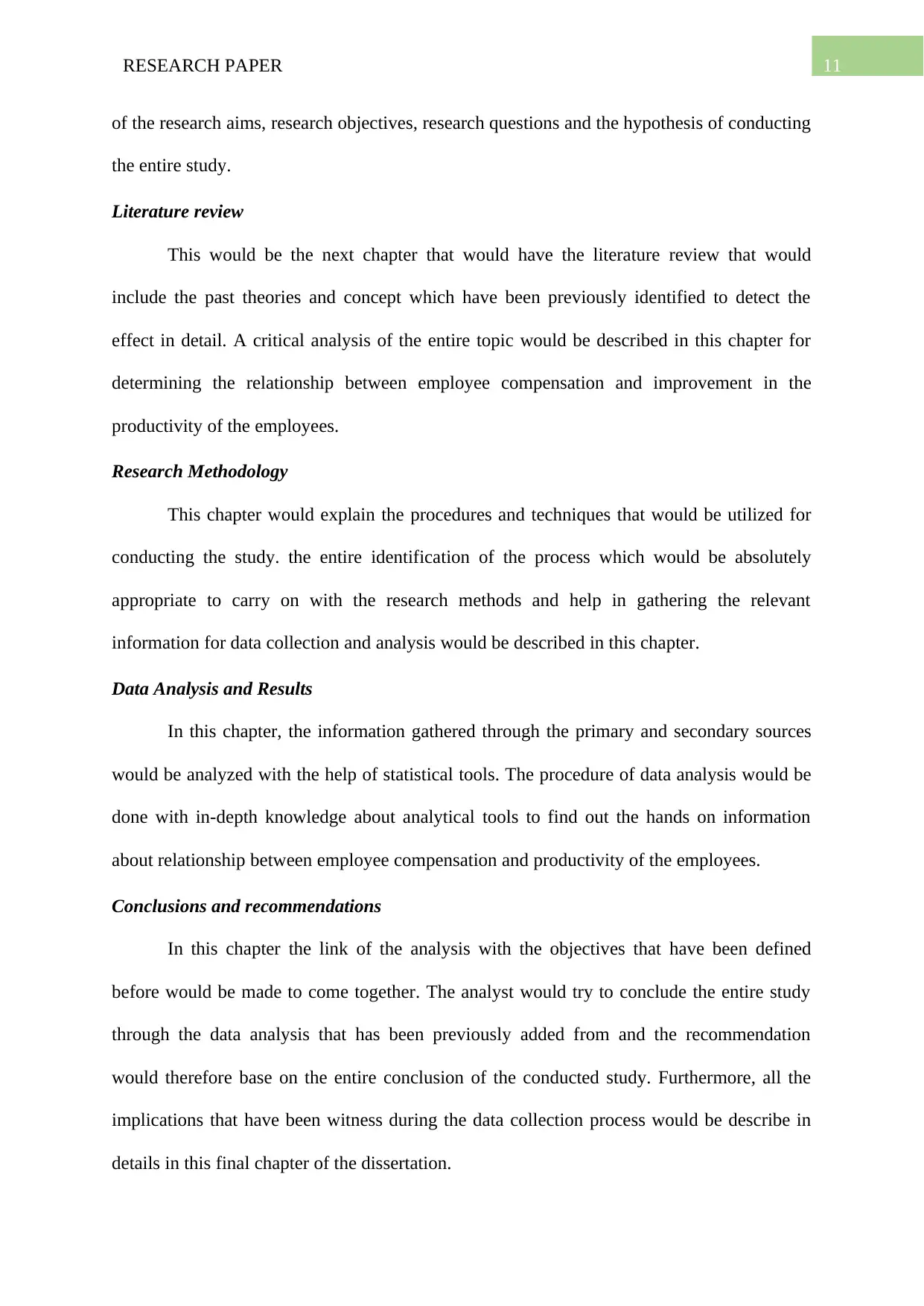
11RESEARCH PAPER
of the research aims, research objectives, research questions and the hypothesis of conducting
the entire study.
Literature review
This would be the next chapter that would have the literature review that would
include the past theories and concept which have been previously identified to detect the
effect in detail. A critical analysis of the entire topic would be described in this chapter for
determining the relationship between employee compensation and improvement in the
productivity of the employees.
Research Methodology
This chapter would explain the procedures and techniques that would be utilized for
conducting the study. the entire identification of the process which would be absolutely
appropriate to carry on with the research methods and help in gathering the relevant
information for data collection and analysis would be described in this chapter.
Data Analysis and Results
In this chapter, the information gathered through the primary and secondary sources
would be analyzed with the help of statistical tools. The procedure of data analysis would be
done with in-depth knowledge about analytical tools to find out the hands on information
about relationship between employee compensation and productivity of the employees.
Conclusions and recommendations
In this chapter the link of the analysis with the objectives that have been defined
before would be made to come together. The analyst would try to conclude the entire study
through the data analysis that has been previously added from and the recommendation
would therefore base on the entire conclusion of the conducted study. Furthermore, all the
implications that have been witness during the data collection process would be describe in
details in this final chapter of the dissertation.
of the research aims, research objectives, research questions and the hypothesis of conducting
the entire study.
Literature review
This would be the next chapter that would have the literature review that would
include the past theories and concept which have been previously identified to detect the
effect in detail. A critical analysis of the entire topic would be described in this chapter for
determining the relationship between employee compensation and improvement in the
productivity of the employees.
Research Methodology
This chapter would explain the procedures and techniques that would be utilized for
conducting the study. the entire identification of the process which would be absolutely
appropriate to carry on with the research methods and help in gathering the relevant
information for data collection and analysis would be described in this chapter.
Data Analysis and Results
In this chapter, the information gathered through the primary and secondary sources
would be analyzed with the help of statistical tools. The procedure of data analysis would be
done with in-depth knowledge about analytical tools to find out the hands on information
about relationship between employee compensation and productivity of the employees.
Conclusions and recommendations
In this chapter the link of the analysis with the objectives that have been defined
before would be made to come together. The analyst would try to conclude the entire study
through the data analysis that has been previously added from and the recommendation
would therefore base on the entire conclusion of the conducted study. Furthermore, all the
implications that have been witness during the data collection process would be describe in
details in this final chapter of the dissertation.
⊘ This is a preview!⊘
Do you want full access?
Subscribe today to unlock all pages.

Trusted by 1+ million students worldwide
1 out of 39
Related Documents
Your All-in-One AI-Powered Toolkit for Academic Success.
+13062052269
info@desklib.com
Available 24*7 on WhatsApp / Email
![[object Object]](/_next/static/media/star-bottom.7253800d.svg)
Unlock your academic potential
Copyright © 2020–2025 A2Z Services. All Rights Reserved. Developed and managed by ZUCOL.





